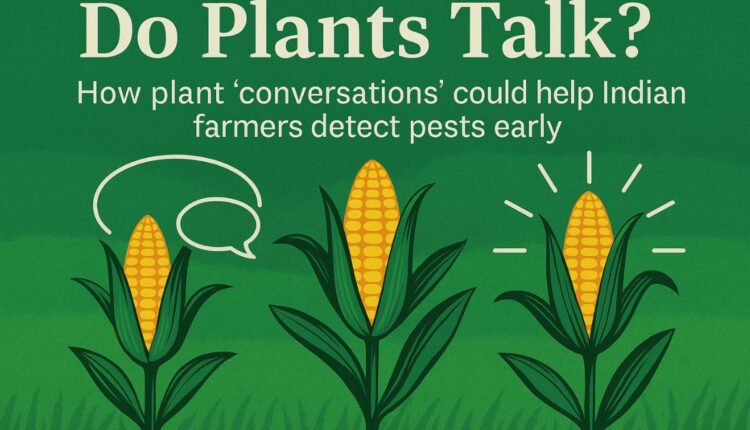Do Plants Talk? For centuries, Indian farmers have relied on keen observation, ancient wisdom, and experience to understand what their crops need. But now, science is uncovering a remarkable new way plants share their distress — through scent.
Plants, it turns out, do talk. Not in words, but in chemical whispers called Volatile Organic Compounds (VOCs). These invisible messages, released especially when under attack, could revolutionize pest detection in Indian agriculture — saving yields, reducing pesticide misuse, and bringing smarter precision to the fields.
What Are VOCs?
Volatile Organic Compounds are small, lightweight molecules that evaporate easily into the air. Plants naturally emit a wide variety of these compounds from their leaves, stems, and roots.
Under normal conditions, these VOCs help in:
Attracting pollinators (like bees and butterflies)
• Repelling herbivores
• Communicating with neighbouring plants
But under stress, especially during pest attacks, fungal infections, or drought, the VOC profile changes dramatically. This is called the “plant distress signal.” (Do Plants Talk)
Plant Alarm System: How VOCs Work Under Attack?
When a pest like the American bollworm starts chewing cotton leaves, the plant quickly emits a distinct blend of VOCs, which:
1. Warn neighbouring plants, prompting them to activate their own defenses.
2. Attract predatory insects that eat the attacking pests (a natural form of biocontrol).
3. Signal to scientists or machines — if captured by sensors — that an attack is underway.
Think of it as a crop sending out a “Help!” signal into the air. And thanks to modern tools, researchers can now listen.
Several Indian agricultural research institutions are working to decode and harness plant VOCs for practical field use:
1. Indian Agricultural Research Institute (IARI), New Delhi
IARI has been experimenting with gas chromatography–mass spectrometry (GC-MS) to map VOCs released by tomato and brinjal crops under whitefly and borer attack. They aim to develop VOC profiles for early diagnosis and pest management solutions.
2. Punjab Agricultural University (PAU), Ludhiana
PAU is collaborating on sensor-based VOC detectors that can be deployed in greenhouses and open fields to give real-time pest alerts, especially for chilli, capsicum, and cotton crops, improving precision pesticide use.
3. Central Institute for Cotton Research (CICR), Nagpur
With cotton being a major cash crop in India, CICR is testing the use of VOC-monitoring tools to detect early infestations by pink bollworms and Helicoverpa armigera, enabling timely interventions in Bt cotton fields.
4. ICAR-National Research Centre for Banana (NRCB), Tiruchirappalli
NRCB has studied VOC emissions in banana cultivars under Fusarium wilt and weevil stress. Their research highlights that certain native banana varieties emit protective VOCs that deter pests or signal early fungal infections, which could guide resistant cultivar selection.
5. Indian Institute of Horticultural Research (IIHR), Bengaluru
IIHR researchers have explored floral and herbivore-induced VOCs in mango and cucumber crops. Their findings show potential in breeding and selecting varieties that emit natural repellent VOCs against thrips, fruit flies, and aphids — reducing pesticide dependence in tropical horticulture.
Field Applications for Indian Farmers: How VOC Science Can Help on the Ground
Farmers can benefit directly from the knowledge and tools being developed around VOCs (Volatile Organic Compounds).
1. Early Warning Systems: Know Before Damage Becomes Visible (Do Plants Talk)
Just like a human gets a fever as a sign of illness, crops also show signs when something is wrong — but often it is too late by the time we see it with our eyes.
With new VOC detectors, sometimes called electronic noses, it is possible to “smell” changes in plant emissions before pest or disease symptoms appear visibly.
How this helps farmers:
• Imagine growing chilli or cotton. A VOC sensor placed in the field can detect pest attacks (like whitefly or bollworm) in the early stages.
This gives farmers time to act quickly — apply biopesticides or neem-based sprays — before the infestation spreads.
• It helps protect the entire crop with minimal intervention.
This is especially useful for horticultural crops, where even a small pest attack can ruin the market value of the produce.
2. Reduced Chemical Usage: Save Money and Protect the Soil
In traditional farming, when one part of the field shows pest signs, the entire field is often sprayed with chemical pesticides, sometimes multiple times — whether needed or not.
But if a VOC alert tells you exactly where the problem is, you can spray only where needed.
Why this matters:
• You use less pesticide, saving on input costs.
The soil stays healthier, and friendly insects like bees and ladybirds are not harmed.
• Over time, this also helps slow down the problem of pesticide resistance in pests, making pest control more effective.
For organic and natural farmers, this technology can support their mission by reducing unnecessary chemical use while still controlling pests early. (Do Plants Talk)
3. Companion Planting: Natural VOCs to the Rescue
Not every farmer will have access to high-tech VOC sensors immediately. But farmers can still make use of natural VOC power through smart planting methods.
Certain plants release helpful VOCs that repel pests or attract beneficial insects. Planting these alongside your main crop can create a natural shield.
Practical examples from Indian fields:
• Marigold + Tomato
Marigold roots release VOCs that repel root-knot nematodes, a common tomato pest. Farmers in Andhra Pradesh and Karnataka have been using this method effectively in polyhouses and open fields.
Tulsi + Brinjal
Tulsi (holy basil) gives off a strong aroma containing VOCs that deter moths and borers, especially in brinjal fields. It’s also a good insect repellent for mosquitoes!
• Maize + Desmodium (used more in Africa, but Indian researchers are testing this)
Desmodium releases VOCs that repel stem borers, while maize attracts the pest — keeping it away from more vulnerable crops.
Benefits for farmers:
• Easy and low-cost — just need to plant the right crops together.
Less need for spraying.
• Encourages a more balanced farm ecosystem.
Even Small Actions Can Lead to Big Changes (Do Plants Talk)
Whether you are a large-scale farmer or a smallholder, understanding how your crops “talk” through VOCs can give you an edge:
| What You Can Do Now | Long-Term Possibility |
| Try companion planting with marigold, tulsi, or lemongrass | Use VOC sensor kits when they become affordable |
| Watch for smell changes in plants under stress | Work with Farmer Producer Organizations (FPOs) to share cost of sniffers |
| Attend KVK trainings on natural pest repellents | Grow VOCs-rich varieties of crops being developed by ICAR institutes |
Real-World Impact: How This Could Change Farming ?
Imagine a small farmer in Maharashtra growing brinjal. Traditionally, he waits to see signs of borer infestation before spraying pesticides. By then, yield loss has already occurred.
With a VOC sensor alerting him within hours of attack, he can take early action — perhaps even using biological agents instead of harsh chemicals.
This can result in:
• Up to 30% higher yield
Lower pesticide residues, crucial for export quality
• Safer food for the local market
Global Examples That Inspire
• Israel: Uses VOC-based sensors in greenhouses for high-value crops like strawberries.
Japan: Robots sniff out changes in VOCs to monitor lettuce crops.
• Kenya: Intercropping desmodium with maize, which releases protective VOCs, has cut stem borer infestations drastically.
India can leapfrog into this future with low-cost, farmer-friendly adaptations.
Challenges in the Indian Context
While promising, the path to VOC-based farming has hurdles: (Do Plants Talk)
| Challenge | Description |
| Cost of sensors | Advanced sniffers or e-noses are still expensive for smallholders |
| Lack of awareness | Most farmers are unaware that crops can “talk” |
| Climate variability | VOC release can vary by humidity, soil, and temperature |
| Need for localization | VOC profiles need to be mapped crop-by-crop and region-by-region in India |
The Way Forward: What India Needs
1. Government and CSR Funding
Support R&D and subsidize pilot sensor projects in major crop belts like Vidarbha (cotton), Guntur (chilli), and Malwa (soybean).
2. Farmer Awareness Campaigns
Use Doordarshan Krishi, Kisan of India, and Krishi Vigyan Kendras (KVKs) to spread knowledge on plant VOCs and eco-friendly pest detection.
3. Affordable VOC Kits
India’s hardware startups can create portable sniffers under ₹5000, paired with mobile apps.
4. Integration with FPOs and SHGs
Train Farmer Producer Organisations and Self Help Groups to use and maintain VOC monitoring kits for community-level benefits.
From Whispering Leaves to Smart Fields
The idea that crops “talk” may sound poetic, but it is rapidly becoming a scientific reality. In India, where over 60% of the population depends on agriculture, turning plants’ silent cries into actionable data could revolutionize farming.
With the right mix of science, innovation, and grassroots adoption, India can lead the world in listening to the language of plants — and responding in time.



